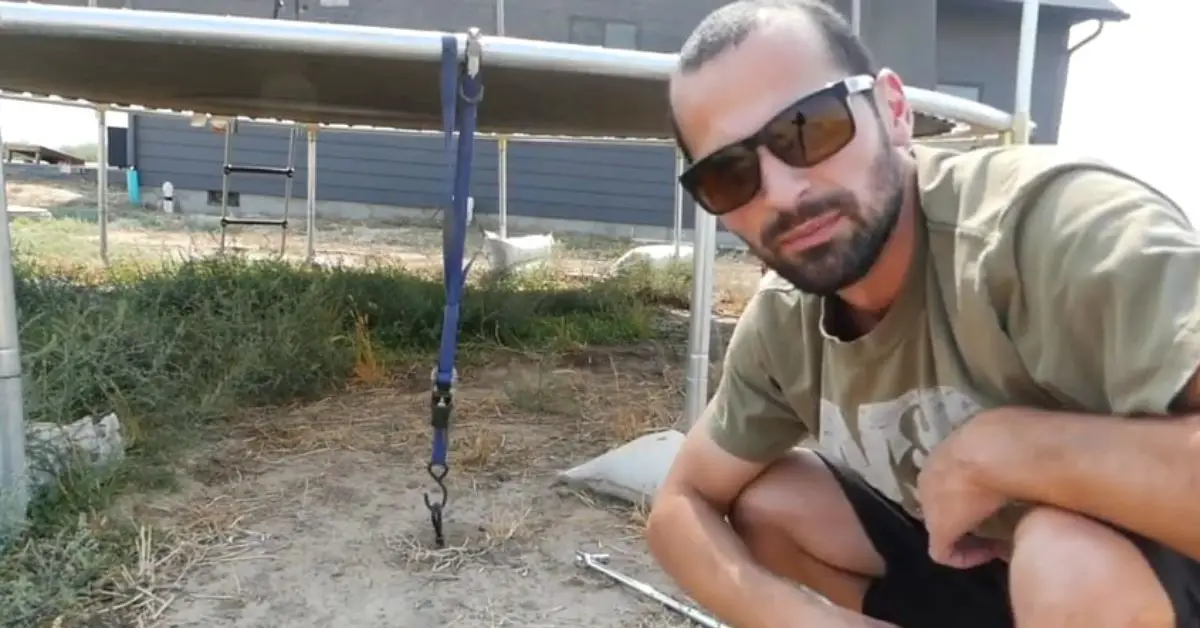Trampolines can be a great source of fun and exercise for the whole family. However, as much as we enjoy using them, it’s important to remember that they can be dangerous in severe weather conditions.
High winds, lightning, and heavy rain can all threaten an unsecured trampoline, and it’s crucial to take the necessary precautions to prevent it from becoming a hazard during a storm.
Securing a trampoline during a storm is a task that should not be taken lightly. A loose or unanchored trampoline can easily be blown away by strong winds, potentially causing significant damage to your property or injuring someone in its path.
Fortunately, you can take a few simple steps to keep your trampoline safe during a storm. In this article, we’ll go over some of the best practices for securing your trampoline so that you can enjoy it safely and confidently, even when the weather takes a turn for the worse.
How to secure trampoline during storm:
High winds and heavy rain can pose a threat to an unsecured trampoline. To prevent it from becoming a hazard, anchor it to the ground with straps or stakes, remove any loose objects, and cover the trampoline with weather-resistant material during a storm.
How To Secure Trampoline during storm?
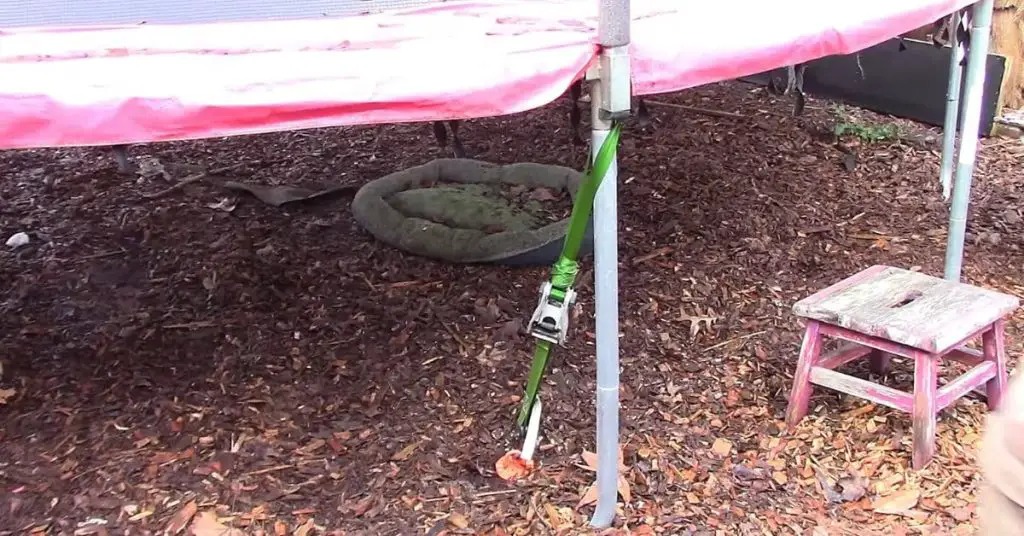
Securing a trampoline during a storm is important to prevent it from being blown away and causing damage or injury.
Here are some steps you can take to secure your trampoline during a storm:
- Remove the safety netting and any other removable parts: If your trampoline has a safety net or other removable parts, remove them before the storm hits. This will reduce the wind resistance and prevent the wind from lifting the trampoline.
- Anchor the trampoline to the ground: Trampolines should permanently be anchored to prevent them from moving around. You can use stakes or heavy-duty straps to anchor the trampoline to the ground. Secure it to something sturdy, such as a tree or a fence post.
- Store the trampoline indoors: If possible, store the trampoline indoors during the storm. This will keep it safe from the wind and other elements. If you don’t have a suitable indoor space, you can cover the trampoline with a tarp to protect it from the rain.
- If you can’t move the trampoline indoors, lay it flat on the ground: If you can’t move the trampoline indoors, lay it flat on the ground and cover it with a tarp. This will reduce the wind resistance and prevent it from being blown away.
- Check the trampoline after the storm: After the storm has passed, check the trampoline for any damage. If there is any damage, don’t use the trampoline until it has been repaired.
By taking these steps, you can help to secure your trampoline during a storm and prevent it from causing damage or injury.
Understanding the risks of high winds on trampolines
Trampolines are popular backyard equipment that provides hours of entertainment for families and children. While they can be a fun way to exercise and play, they can also pose a significant risk during high winds or storms. The high surface area of a trampoline makes it more susceptible to wind resistance and can cause it to be lifted or blown away.
we will discuss the risks of high winds on trampolines, how wind can move a trampoline, what wind speed can lift a trampoline, and how different types of trampolines can affect wind resistance.
How Wind Can Move a Trampoline
Trampolines can be very vulnerable to high winds, especially when they are not anchored or secured properly. A strong gust of wind can cause a trampoline to become airborne, potentially causing damage to property and injuring people.
When high winds are present, they create uneven pressure on the trampoline’s surface, which can cause it to move or even lift off the ground.
The main factor that affects how wind moves a trampoline is its surface area. The larger the surface area of the trampoline, the more it will be affected by wind resistance. The shape of the trampoline can also affect its wind resistance.
For example, trampolines with enclosure nets can act like a sail and catch the wind, making them more susceptible to movement or lift-off.
What Wind Speed Can Lift a Trampoline
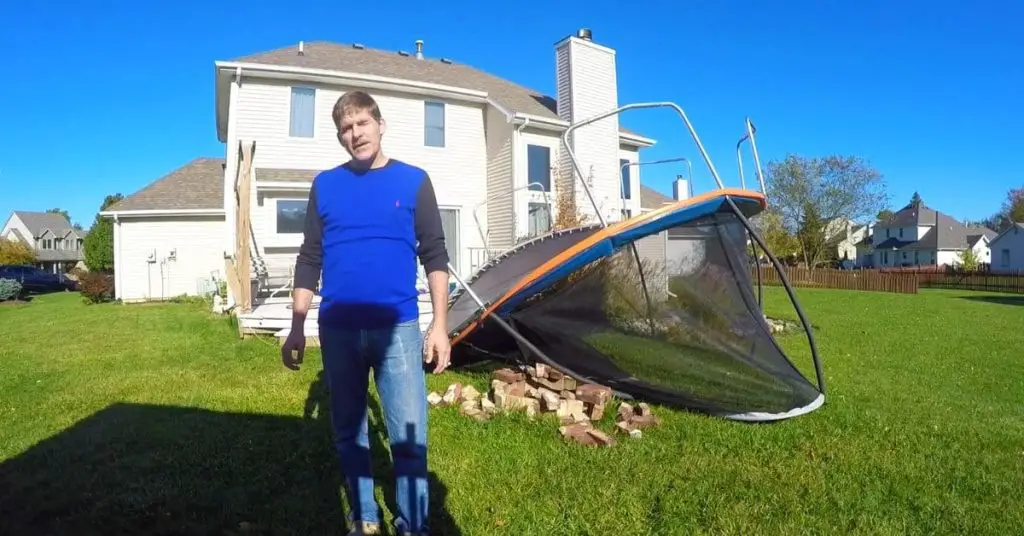
It’s important to note that wind speed alone is not the only factor that can cause a trampoline to be lifted or blown away. The direction and duration of the wind also play a significant role in determining the risk of damage to the trampoline.
According to the National Weather Service, a wind speed of 40 to 60 mph can cause significant damage to property, including trampolines.
In addition, the type of trampoline and its weight can also affect the wind speed required for it to be lifted.
A lighter trampoline will be more susceptible to wind resistance and lift-off than a heavier one. It’s important to consider your area’s wind conditions and take appropriate measures to secure your trampoline.
How Different Types of Trampolines Can Affect Wind Resistance

The type of trampoline can also play a significant role in its wind resistance. Spring trampolines are the most common type of trampoline, but they can be more susceptible to wind resistance than springless trampolines.
The springs on a trampoline act like a sail, catching the wind and increasing the wind resistance. On the other hand, springless trampolines have a lower surface area and are less likely to catch the wind.
Enclosure nets can also affect the wind resistance of a trampoline. While they provide added safety by preventing people from falling off the trampoline, they can also act like a sail and catch the wind, making it more susceptible to movement or lift-off.
In areas with high wind conditions, choosing a trampoline without an enclosure net or securing it properly may be beneficial.
Choosing the right method to secure a trampoline
When setting up a trampoline, securing it in place is crucial for the safety of those using it. There are different methods for anchoring a trampoline and choosing the right one depends on various factors.
Factors to Consider When Choosing a Method:
The factors to consider when choosing a method depend on the context in which you are choosing a method. However, in general, some factors to consider when choosing a method include:
Soil Type:
The type of soil you have in your backyard will play a significant role in determining the anchoring method. For instance, if you have loose or sandy soil, you may need a more robust anchoring method than clay soil.
Location
Where you plan to set up the trampoline will also determine the best anchoring method. If you’re setting up on a hard surface like concrete or asphalt, you may need different anchors than if you’re setting up on grass.
Trampoline Size:
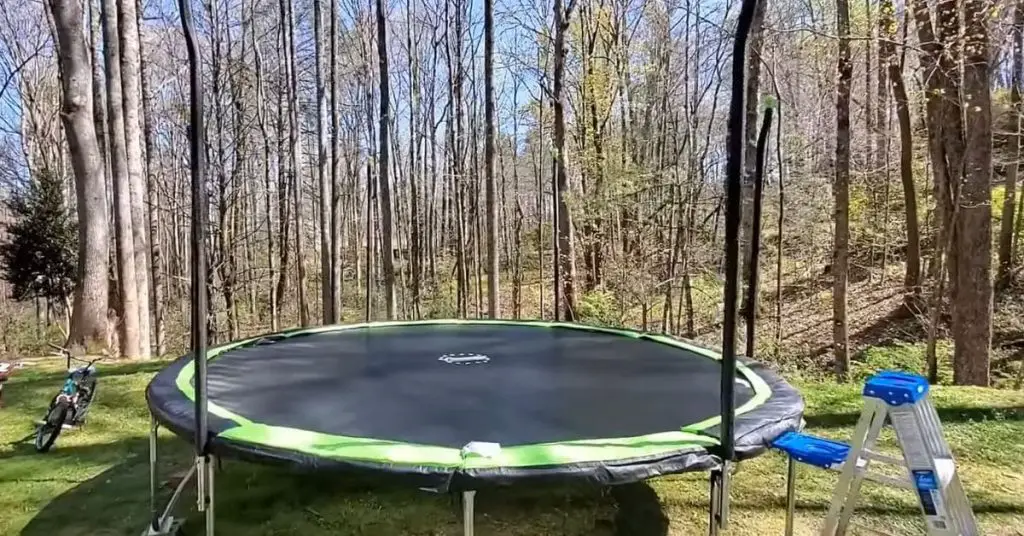
The trampoline size will also influence the type of anchoring method you need. Larger trampolines will require more substantial anchors than smaller ones.
Weather Conditions:
Your area’s climate and weather patterns should also be considered when choosing a trampoline anchoring method. For instance, if you live in an area prone to high winds, you’ll need an anchoring method to withstand strong gusts.
Pros and Cons of Different Anchoring Methods:
Anchoring is used in research and surveys to provide participants a reference point or starting point when answering questions. There are several types of anchoring methods, each with pros and cons. Here are some of the most common anchoring methods and their pros and cons:
U-Shaped Anchors:
U-shaped anchors are one of the most popular methods of anchoring trampolines. They are affordable and easy to install, requiring only a hammer to drive them into the ground. However, they may not be suitable for loose or sandy soil, as they can pull out of the ground easily.
Spiral Anchors:
Spiral anchors are similar to U-shaped anchors but have a spiral shape, making them more resistant to pulling out of the ground. They are ideal for most soil types and can be easily installed with a wrench or drill. However, they may not be suitable for hard surfaces like concrete.
Auger Anchors:
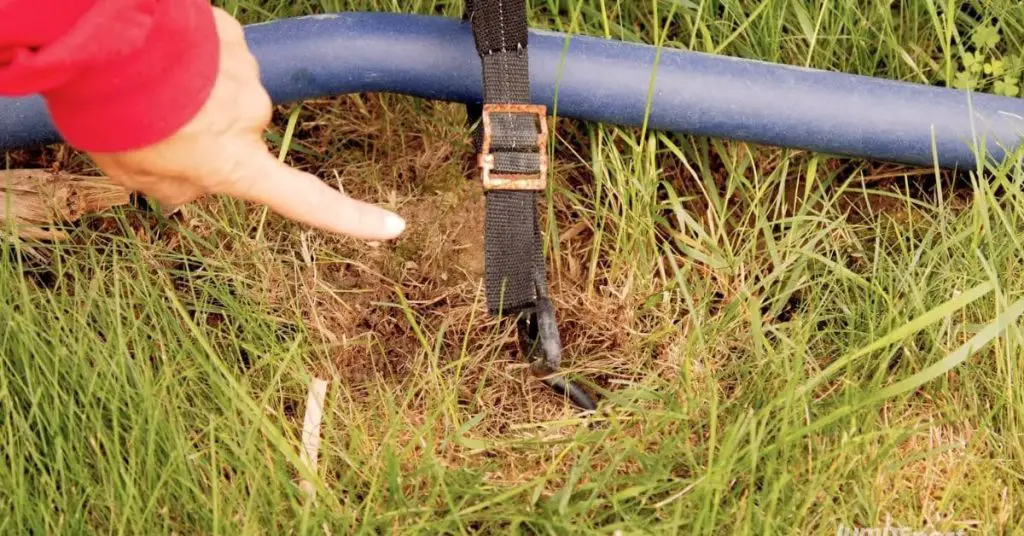
Auger anchors are another popular method of securing trampolines. They have corkscrew shapes, ideal for sandy or loose soil types. They can be easily installed with a wrench or drill and are very secure. However, they may not be suitable for hard surfaces.
Cement Anchors:
Cement anchors involve pouring cement into the ground and placing the trampoline legs into the cement. They are one of the most secure anchoring methods but require more installation time and effort. They are suitable for all soil types but may not be practical for those who plan to move the trampoline frequently.
Sandbags:
Sandbags are a popular alternative to traditional anchoring methods. They are easy to use and can be placed on top of the trampoline legs or tied to the frame. However, they are not as secure as other methods and may not withstand high winds or heavy rain.
Additional steps to secure trampolines
While choosing the right anchoring method is essential for securing a trampoline, you can also take some additional steps to increase its stability and safety. Here are some of the most effective ways to secure a trampoline:
Install a Safety Enclosure:
A safety enclosure, also known as a net, can help prevent falls from the trampoline. It is important to ensure that the enclosure is properly attached to the trampoline and that it is in good condition.
A safety enclosure can also prevent children and pets from crawling under the trampoline, reducing the risk of injury.
Use Trampoline Skirts:
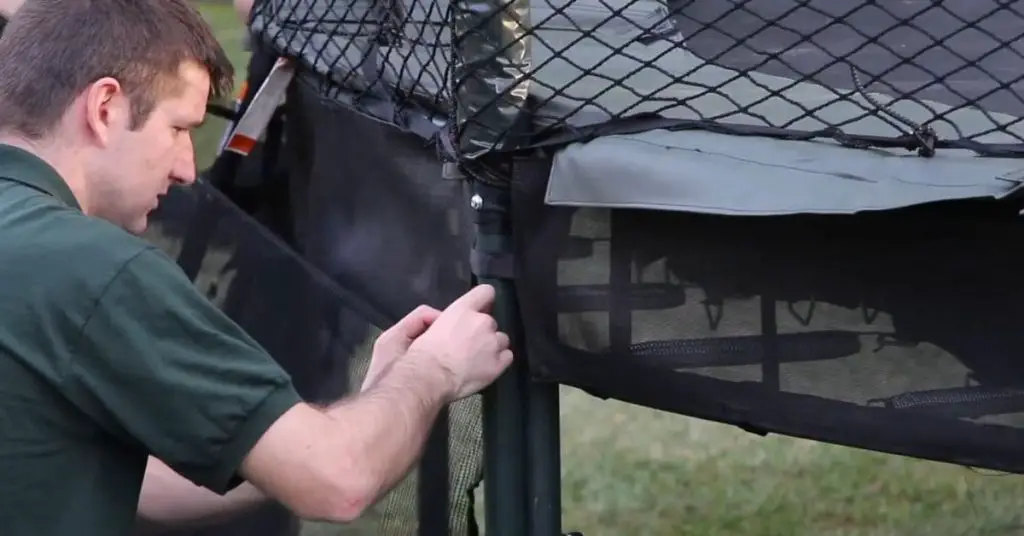
Trampoline skirts, also known as wind skirts, are designed to cover the springs and frame of the trampoline, preventing debris from getting trapped in them. They can also help to reduce wind resistance and improve the stability of the trampoline.
Regular Maintenance:
Regular maintenance of your trampoline can help to ensure its stability and safety. Check the trampoline regularly for signs of wear and tear, such as rust, tears, or broken springs. Tighten any loose bolts or nuts, and replace any damaged parts promptly.
Weighted Anchors:
Weighted anchors, such as sandbags or cinder blocks, can secure the trampoline legs to the ground. They are instrumental when setting up the trampoline on a hard surface such as concrete. Ensure the weights are evenly distributed and securely attached to the trampoline legs.
Limit Jumpers:
Limit the number of people using the trampoline at any one time. Overcrowding can cause the trampoline to become unstable and increase the risk of injury.
By taking these additional steps to secure your trampoline, you can help ensure it is as safe as possible for those using it. Remember that trampoline safety is everyone’s responsibility, so make sure that anyone using the trampoline is aware of the safety rules and guidelines. With the right anchoring method and additional safety measures, you can enjoy your trampoline with peace of mind.
Different methods to secure a trampoline
Trampolines are a popular recreational item for families, but they can also be a safety hazard if not properly secured. The weight and height of trampolines make them susceptible to tipping over or getting carried away by strong winds, posing a threat to the people around them.
Therefore, it is important to secure trampolines to prevent accidents and remain stable during use.
we will discuss different methods to secure a trampoline, including taking it down, using cork-screw anchors, U-shaped anchors, and sandbags. Additionally, we will cover how to secure a trampoline on concrete and on a deck.
Take it down or remove it
One way to secure a trampoline is to take it down or remove it entirely. This method is suitable for people who only use the trampoline occasionally or briefly, such as during the summer.
Taking down the trampoline and storing it in a safe location when not in use can eliminate the risk of it tipping over or getting damaged by extreme weather conditions.
Use cork-screw anchors (augers)
Cork-screw anchors, also known as augers, are a popular method for securing trampolines. They are easy to install and are designed to dig into the ground, providing a stable foundation for the trampoline.
Cork-screw anchors work best in soil and are not recommended for use on hard surfaces like concrete or a deck. To use cork-screw anchors, drill them into the ground at an angle, and attach them to the trampoline frame using straps or ropes.
Use U-shaped anchors (wind stakes)
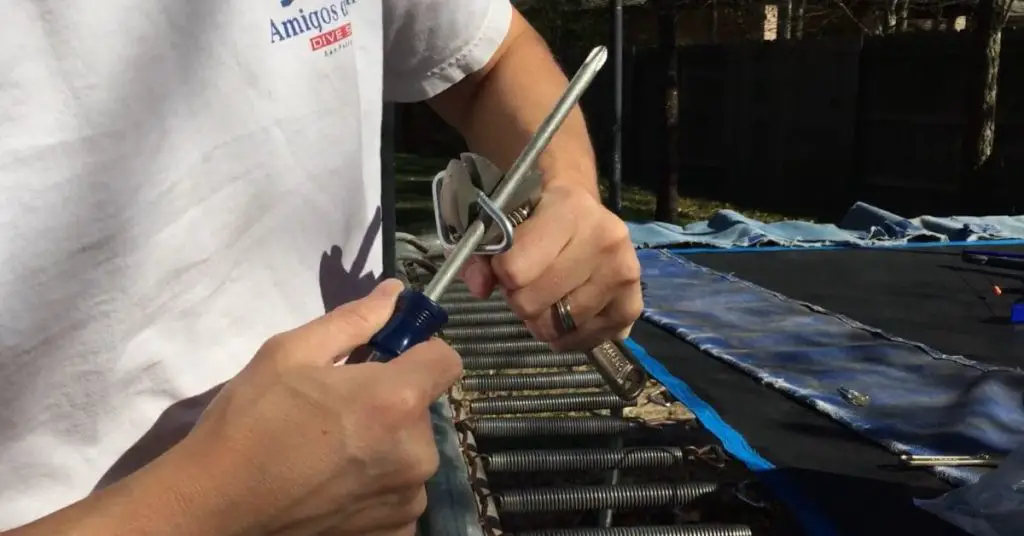
U-shaped anchors, also known as wind stakes, are another popular method for securing trampolines. These anchors are made of metal and are designed to be driven into the ground at an angle, creating a secure hold.
They work best in soil or grass and are not recommended for use on hard surfaces like concrete or a deck. Using straps or ropes, hammer them into the ground at an angle, and use U-shaped anchors to attach them to the trampoline frame.
Use sandbags
Sandbags are another way to secure a trampoline. They work best on hard surfaces like concrete or a deck. To use sandbags, place them on the legs of the trampoline or on the frame, making sure that they are evenly distributed. You can also use bungee cords or ropes to secure the sandbags to the trampoline frame.
How to secure a trampoline on concrete
Securing a trampoline on concrete requires a different approach than securing it on soil or grass. Here are some methods to consider:
- Use sandbags: As mentioned above, sandbags are an effective way to secure a trampoline on concrete. You can place sandbags on the legs of the trampoline or on the frame to keep it stable.
- Use concrete anchors: Concrete anchors are a more permanent solution for securing a trampoline on concrete. These anchors require drilling holes in the concrete and inserting the anchor bolts. Then, attach the trampoline legs to the anchor bolts using nuts and washers.
- Use rubber matting: Rubber matting can also help to stabilize a trampoline on concrete. Place the matting under the legs of the trampoline to provide a non-slip surface that will prevent the trampoline from sliding.
How to secure a trampoline on a deck
Securing a trampoline on a deck can be tricky, but it is possible. Here are some methods to consider:
- Use U-shaped anchors: U-shaped anchors can secure a trampoline to a deck. Drill holes in the deck and hammer the anchors into the holes, ensuring they are at an angle. Attach the anchors to the trampoline frame using straps or ropes.
- Use sandbags: Sandbags can also secure a trampoline on a deck. Place sandbags on the legs of the trampoline or on the frame to keep it stable. Make sure that the weight of the sandbags is evenly distributed.
- Use brackets: Brackets can secure a trampoline to a deck. Attach the brackets to the trampoline legs and the deck using screws or bolts. This method provides a more permanent solution but may require drilling holes in the deck.
Best practices for trampoline safety during storms
Trampolines are a popular source of outdoor fun and exercise, but they can also pose a serious safety risk during storms. High winds, heavy rain, and lightning strikes can cause trampolines to tip over, fly away, or become damaged, potentially causing harm to people and property.
Therefore, it is important to follow best practices for trampoline safety during storms to minimize these risks.
we will discuss the top four best practices for trampoline safety during storms: regular maintenance and inspection, monitoring weather forecasts, ensuring proper installation and assembly, and using high-quality trampolines and anchoring equipment.
Regular maintenance and inspection of trampolines
The first best practice for trampoline safety during storms is to regularly inspect and maintain your trampoline. This includes checking the frame, springs, mat, and padding for any signs of wear and tear or damage.
Over time, trampolines can weaken or damage, making them more susceptible to damage during storms. If you notice any signs of damage or wear and tear, it is essential to address the issue before the next storm arrives. You should also check the trampoline after each storm to ensure it is still in good condition.
Monitoring weather forecasts and taking action accordingly
The second best practice for trampoline safety during storms is to monitor weather forecasts and take action accordingly closely. Before a storm hits, bring your trampoline indoors or take it down if possible. If you cannot take the trampoline down, ensure it is properly secured with high-quality anchoring equipment.
Additionally, you should avoid using the trampoline during storms or immediately after heavy rain. The trampoline’s surface can become slippery, making it more difficult to maintain balance and increasing the risk of injury.
Ensuring trampolines are properly installed and assembled
The third best practice for trampoline safety during storms is to ensure that your trampoline is properly installed and assembled. Follow the manufacturer’s instructions carefully to ensure the trampoline is set up correctly.
This includes ensuring that the trampoline is on a level surface and that all springs, pads, and mats are securely attached. If you are not confident in your ability to assemble the trampoline correctly, it is best to hire a professional to do it for you.
Importance of using high-quality trampolines and anchoring equipment
The fourth best practice for trampoline safety during storms is to use high-quality trampolines and anchoring equipment. Cheap or low-quality trampolines are more likely to become damaged or weakened over time, increasing the risk of accidents during storms.
Therefore, investing in a high-quality trampoline designed to withstand harsh weather conditions is essential.
Additionally, ensure you use high-quality anchoring equipment, such as cork-screw or U-shaped anchors, to secure the trampoline to the ground.
Anchoring equipment not designed for trampolines or poorly made may fail during storms, putting people and property at risk.
FAQs
Q.1 Why is it important to secure a trampoline during high winds or hurricanes?
It is important to secure a trampoline during high winds or hurricanes to prevent it from being blown away, causing damage to property or injuring people. A trampoline that is not anchored properly can become a dangerous projectile in high winds.
Q.2 How do I know if my trampoline needs to be secured?
If you live in an area prone to high winds or hurricanes, securing your trampoline before a storm hits is important. You can also check your area’s weather forecast to see if any strong winds are expected.
Q.3 What are the different methods of securing a trampoline?
Several methods of securing a trampoline include using anchor kits, sandbags, or tie-down straps. Each method has its advantages and disadvantages, and you should choose the one that works best for your situation.
Q.4 How do I use an anchor kit to secure my trampoline?
An anchor kit typically includes several stakes that are driven into the ground around the trampoline and attached to the legs of the trampoline using straps or cables. This helps to keep the trampoline from being lifted off the ground in high winds.
Q.5 Can I use sandbags to secure my trampoline?
Yes, sandbags can be used to weigh down the legs of a trampoline to prevent it from being blown away. Make sure to use enough sandbags and distribute them evenly around the legs of the trampoline.
Q.6 How do I use tie-down straps to secure my trampoline?
Tie-down straps are attached to the legs of the trampoline and then anchored to the ground using stakes or screws. Tighten the straps properly to prevent any movement during high winds.
Q.7 How often should I check the security of my trampoline?
It is recommended to check the security of your trampoline before and after every use, especially if you have children who use it frequently. You should also check it before any storm or high wind event.
Conclusion
In conclusion, securing a trampoline during a storm is crucial to prevent it from being blown away, causing damage or injury. High winds can lift a trampoline, and different types of trampolines can affect wind resistance. Therefore, it is essential to choose the right method to secure a trampoline, considering factors such as the location, the type of trampoline, and soil type.
Various methods can anchor a trampoline, such as cork-screw anchors, U-shaped anchors, and sandbags. It is also possible to secure a trampoline on concrete or a deck. However, taking additional steps to ensure trampoline safety during storms is essential, such as monitoring weather forecasts and regularly inspecting and maintaining trampolines.
Using high-quality trampolines and anchoring equipment is also critical for ensuring trampoline safety during storms. By following best practices for trampoline safety, individuals can help to reduce the risks associated with trampolines and prevent accidents or injuries.
Overall, securing a trampoline during a storm requires careful consideration of various factors and implementing appropriate measures to prevent damage or injury.
We hope that after reading this detailed guide on securing a trampoline during a storm, you now understand what you need to do to keep your trampoline safe. If you have any questions, please ask us in the comments section below!

